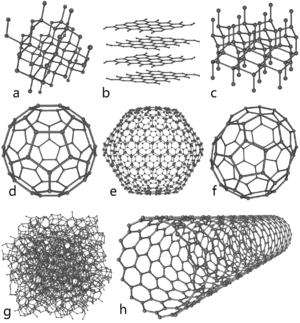Carbon Nanotubes
by denamolnar
By Dena Molnar, Daekwon Park, Jill Sherman
Applications of Carbon Nanotubes are an exciting area of exploration in that they display a number of performative qualities and they are still considered a relatively new discovery (about 20 yrs old). Aside from their extreme mechanical strength, the electronic properties of CNTs, which can be either metallic or semiconducting, make this a unique material. High thermal conductivity and chemical resistance are additional qualities. Together, the properties of this material lend itself well to sensory and actuation applications, field emitters, semiconducting components, energy storage devices, and have broad implications for use in the product design, architecture and textile fields.
Structure and Properties
Carbon is unique among the elements in its ability to take on many different structural formations. Carbon nanotubes or CNTs are part of a class of carbons referred to as Alltropes of Carbon. Alltropes of carbon are the different molecular configurations (alltropes) that carbon can take. Put another way, Carbon nanotubes are essentially rolled up tubes of carbon atoms.
The hardest known alltrope of carbon is diamond, while one of the softest is Graphite, or “graphein”, which is conductive and the the most common form of carbon nanotube.
Thermal conductivity- Carbon-based materials, diamond and “in-plane” graphite display the highest measured thermal conductivity of any known material at moderate temperatures.
mechanical properties- Nanotubes are recognized for their strength (one of the strongest materials known) and elasticity. Single walled nanotubes are most commonly used because they can be grown with fewer defects and are, for this reason, stronger. Because nanotubes are essentially ”rolled up” graphein, they are capable of elastic deformation, where the shape of the nanotube may change, but the local structure does not. While they are also capable of local and irreversible deformation on the atomic level, they can bend reversibly at very high angles and their tensile strength is unmatched.
electrical properties- Carbon nanotubes can be either metallic or semiconducting. This is advantageous because metallic conductors may burn up or out more easily. “Whether a nanotube is a metal or semiconductor depends on the properties of the electrons in the tubes. Carbon nanotubes are unique in that small differences in their diameter and chirality affect whether it is a metal or a semiconductor. For most other materials, its metallic or semiconducting nature depends mainly on its chemical composition and the 2-D arrangement of atoms and molecules”. Physics Graphics: http://www.aip.org/png/html/nanotube.htm
Adhesion – The aligned growth of CNTs allows for highly adhesive technical surfaces to be generated, which work according to the Van der Waals force. This is the same principle behind why a gecko can stick to glass surfaces. The contact surface area provided by these vertically aligned tubes is large enough that forces of attraction act between the ends of the nanotubes and the molecules of the substrate.
Varieties and Applications
Although large scale applications of CNTs are well documented. (ie. as an additive for increasing the strength of plastics), their potential in smaller applications and in the creative realm is still being explored. Examples of novel applications are listed below:
-As sighted in “Smart Surfaces”, by Thorsten Klooster, researchers at Rensselaer Polytechnic Institute have developed one of the darkest known synthetic materials via the controlled growth of nanotubes. This material only reflects 0.15% of incoming light, compared with traditional black pigment, which reflects between 5-10%. The high level of absorption is attributed to the vertical positioning of the nanotubes and their “porous” quality, allowing light to penetrate further into the surface. Greater levels of light absorption is of interest for efficient solar energy conversion applications. Link to pdf - RPI
Conductive nanotube ink, polymers, and thin films are on the market .
Resources
Below are a list of links to Resources to obtain various components containing Carbon Nanotubes. Additional pdfs with process, specification, and safety guidelines are also included.
SWeNT
Producer of ready to use Carbon Nanotube Ink for Screen Printed applications http://swentnano.com
Printing process recommendations SWeNT
Product Identification and Safety
NanoLab
Producer of Carbon Nanotube Inks for the printing of nanotube electronics and sensors.
Buckypaper http://www.nano-lab.com/buckypaper.html
Nanotube Ink http://www.nano-lab.com/nink.html
US Research NanoMaterials, Inc
Papers/ Articles
Thermal properties of carbon nanotubes: Thermal_conductivity
Mechanical and electrical properties of carbon nanotubes: Mechanical.Electrical
Carbon Nanotube dye may put a capacitor in your Shorts: http://arstechnica.com/science/news/2010/01/carbon-nanotubes-bind-to-fabric-to-make-wearable-electronics.ars
Conducting Textiles from single walled carbon nanotubes:
http://www.sciencedirect.com/science/article/pii/S0379677907000914
Carbon Nanotube Thread: http://www.technologyreview.com/computing/21689/
Class Presentation - Carbon_Nanotubes
